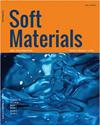pH modulating agar dressing for chronic wounds
IF 1.4
4区 材料科学
Q4 MATERIALS SCIENCE, MULTIDISCIPLINARY
引用次数: 4
Abstract
ABSTRACT Microenvironment of majority chronic wounds exhibits pH in the range of 7.5 to 8.5, leading to poor healing prognosis. The elevated pH adds to dysregulation of healing cascade by creating hypoxia, elevating matrix metalloproteinase (MMP) activity and chances of infection. The current work focuses on fabrication of pH regulating agar-citric acid bi-layer dressing for effective management of chronic wounds. The desired pH in the range of 6 to 7 was achieved by unidirectional release of citric acid through bi-layer arrangement of agar-citric acid films in contact with wound simulating fluid of pH ~ 8.5. At lower pH (6.5), both MMP 9 and MMP 2 degraded lesser gelatin (0.11 µg/mg ± 0.003 µg/mg) as compared to higher pH (8.5) value (0.18 µg/mg ± 0.004 µg/mg). The dressing also exhibited bacteriostatic effect on Staphylococcus aureus and Pseudomonas aeruginosa bacteria cultured in-vitro. The bilayer dressing exhibited an average tensile strength of 27 MPa ± 2.5 MPa along with 52 ± 5% elongation at break. The percentage swelling and water vapor transmission rate of dressing was 112% ± 20% and 2156 g/m2/day ± 128 g/m2/day respectively.用于慢性伤口的pH调节琼脂敷料
摘要大多数慢性伤口的微环境pH值在7.5至8.5之间,导致愈合预后不佳。升高的pH通过产生缺氧、提高基质金属蛋白酶(MMP)活性和感染机会,增加了愈合级联的失调。目前的工作重点是制作pH调节琼脂-柠檬酸双层敷料,以有效治疗慢性伤口。通过与pH~8.5的伤口模拟液接触的琼脂-柠檬酸膜的双层排列单向释放柠檬酸,实现了6至7范围内的所需pH。在较低的pH值(6.5)下,MMP 9和MMP 2对明胶的降解程度较低(0.11µg/mg±0.003µg/mg),而对较高pH值(8.5)的降解程度较高(0.18µg/mmg±0.004µg/mg)。该敷料对体外培养的金黄色葡萄球菌和铜绿假单胞菌也有抑菌作用。双层敷料的平均拉伸强度为27 MPa±2.5 MPa,断裂伸长率为52±5%。敷料的溶胀率和水蒸气透过率分别为112%±20%和2156 g/m2/天±128 g/m2/天。
本文章由计算机程序翻译,如有差异,请以英文原文为准。
求助全文
约1分钟内获得全文
求助全文
来源期刊

Soft Materials
工程技术-材料科学:综合
CiteScore
2.90
自引率
0.00%
发文量
21
审稿时长
2.2 months
期刊介绍:
Providing a common forum for all soft matter scientists, Soft Materials covers theory, simulation, and experimental research in this rapidly expanding and interdisciplinary field. As soft materials are often at the heart of modern technologies, soft matter science has implications and applications in many areas ranging from biology to engineering.
Unlike many journals which focus primarily on individual classes of materials or particular applications, Soft Materials draw on all physical, chemical, materials science, and biological aspects of soft matter. Featured topics include polymers, biomacromolecules, colloids, membranes, Langmuir-Blodgett films, liquid crystals, granular matter, soft interfaces, complex fluids, surfactants, gels, nanomaterials, self-organization, supramolecular science, molecular recognition, soft glasses, amphiphiles, foams, and active matter.
Truly international in scope, Soft Materials contains original research, invited reviews, in-depth technical tutorials, and book reviews.
 求助内容:
求助内容: 应助结果提醒方式:
应助结果提醒方式:


